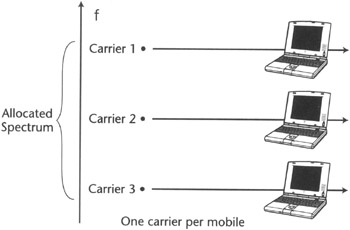1G Cellular Systems
1G Cellular Systems
First-generation cellular systems have been around for a few decades now, and we expect them to remain in place for some time because of the significant infrastructure investments made by operators. All of these systems support circuit data services and may be utilized for various forms of mobile VPN, albeit not without difficulties. This section provides a high-level overview of the air interfaces utilized by most widely deployed 1G systems.
AMPS
All 1G cellular systems rely on analog frequency modulation for speech and data transmission and in-band signaling to move control information between terminals and the rest of the network during the call. Advanced Mobile Phone System is a good example of first-generation analog technology mostly used in the United States. AMPS is based on FM radio transmission using the FDMA principle where every user is assigned their own frequency to separate user channels within the assigned spectrum (see Figure 3.2). FDMA is based on narrowband channels, each capable of supporting one phone circuit that is assigned to a particular user for the duration of the call. Frequency assignment is controlled by the system, and transmission is usually continuous in both uplink and downlink directions. The spectrum in such systems is allocated to the user for the duration of the call, whether it is being used to send voice, data, or nothing at all.
 Figure 3.2: Frequency Division Multiple Access (FDMA) principles.
Figure 3.2: Frequency Division Multiple Access (FDMA) principles.
As with other 1G technologies, in AMPS a circuit—represented by a portion of spectrum—is allocated to the user and must remain available for this user, similar to the telephone copper pair used for voice communications. Similar to the analog wireline connection, a modem is also used for data access (see Chapter 4 for more on this). Error correction protocols used by wireless modems tend to be more robust than their landline counterparts, because of the necessity of dealing with a more challenging physical environment with inherently higher interference and signal-to-noise ratios than copper or fiber. The peak data rate for an AMPS modem call under good conditions is usually up to 14.4 Kbps, and as low as 4.8 Kbps under poor conditions. It can take anywhere up 20 seconds or more to establish an AMPS data connection.
Nordic Mobile Telephone and Total Access Communication System
Nordic Mobile Telephone system was originally introduced in 1981 in four northern European countries—Denmark, Finland, Norway, and Sweden— in the 450-MHz frequency band, which was available at that time. Total Access Communication System (TACS) was deployed three years later in the United Kingdom and later spread to other European countries such as Italy. Both systems are based on analog FDMA radio access technology, as you would expect from a typical 1G system.
Initially, NMT was optimized for use in the sparsely populated rural environment common for Scandinavian countries. A 450-MHz frequency allowed for installation of large cells because of better propagation characteristics at higher frequencies. As business and environmental conditions changed, NMT was modified to operate in the 800-MHz range, taking into account the size and power of handsets. In contrast, TACS was designed for capacity rather than coverage. TACS systems operate in 800- and 900-MHz frequencies, which require a larger numbers of cell sites but allow for smaller and less powerful transmitters. This system proved to be very efficient and economical for countries such as the UK, with high population density and large numbers of urban areas.
Both NMT and TACS are still in use, but their customer base is eroding fast because of the widespread availability of more advanced and cost-effective GSM services. In some cases, regulators are asking operators to phase out analog (1G) systems and return the spectrum license after the subscriber numbers reach a certain low value. In these circumstances, operators, who want to retain the customer base, offer very attractively priced packages to entice analog customers to stay with the system for as long as possible.







